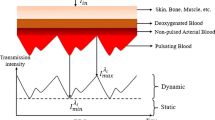Abstract
The goal of the study was to measure glycated hemoglobin (HbA1c) by means of photoacoustic spectroscopy (PAS). Absorption spectra from 250 nm to 750 nm were obtained at room temperature from six commercial standards of HbA1c. The sample (60 \(\mu L\)) was confined in a photoacoustic cell. The cell was impinged with a monochromatic light originated in xenon lamp (700 W) and was modulated in a mechanical optical chopper (fixed at 17 Hz). The modulated light heated the sample which releases the heat to the air in the cell, producing changes in pressure that were detected by a microphone and amplified to be recorded as an absorption spectrum. Five measurements were performed in every standard. The area under the curve (auc) of the spectra (250 nm to 750 nm) significantly correlated (p = 0.01) with and was dependent on the standard HbA1c concentration (3.1 % to 19.8 %). As far as we know, it is the first time that PAS has been used to detect HbA1c. It is concluded that PAS, a non-destructive technique, is a suitable technology to measure Hba1c, with the advantages of using small samples that are available for the measurement of other substances by the same technology.



Similar content being viewed by others
Data availability
Not applicable. Data availability program package, available from the corresponding author upon request.
References
Y. Zheng, S.H. Ley, F.B. Hu, Nat. Rev. Endocrinol. 14, 88 (2018)
A.D. Association, Diabetes Care 4, S15 (2021)
A. Ceriello, G. Lucisano, F. Prattichizzo, R. La Grotta, S. Franzén, A.M. Svensson, B. Eliasson, A. Nicolucci, Cardiovasc. Diabetol. 21, 1 (2022)
S.I. Sherwani, H.A. Khan, A. Ekhzaimy, A. Masood, M.K. Sakharkar, Biomark. Insights 11, 95 (2016)
H. Sun, P. Saeedi, S. Karuranga, M. Pinkepank, K. Ogurtsova, B.B. Duncan, C. Stein, A. Basit, J.C. Chan, J.C. Mbanya, M.E. Pavkov, IDF Diabetes Atlas: Global, Regional and Country-Level Diabetes Prevalence Estimates for 2021 and Projections for 2045 (Elsevier, Amsterdam, 2021)
S.J. Olvera Vazquez, C. Villanueva López, M. Macías Mier, M.L. Alvarado Noguez, A. Cruz Orea, Int. J. Thermophys. 40, 1 (2019)
M.L. Alvarado-Noguez, P. Rojas-Franco, E. Cano-Europa, M. Franco-Colín, C. Hernández-Aguilar, F.A. Domínguez-Pacheco, A. Cruz-Orea, F. Sánchez-Sinencio, Int. J. Thermophys. 39, 1 (2018)
A. Rosencwaig, A. Gersho, J. Appl. Phys. 47, 64 (1976)
S.L. Busaidy, Photoacoustic Sensor for In-Vivo Non-invasive Blood Glucose Measurements (Mads Clausen Institute University of Southern Denmark, Sønderborg, 2021)
A. Rosencwaig, Photochem. Photobiol. 34, 749 (1981)
C. Hernandez-Aguilar, A. Dominguez-Pacheco, C. Valderrama-Bravo, A. Cruz-Orea, E. Martínez Ortiz, J. Ordonez-Miranda, Food Bioprocess Technol. 13, 2104 (2020)
M.V. Marquezini, N. Cella, A.M. Mansanares, H. Vargas, L.C.M. Miranda, Meas. Sci. Technol. 2, 396 (1991)
R.M. Ricardo, Aplicación de Espectroscopía Fotoacústica Para Caracterización de Grano de Maíz ( Zea Mays L .): Visión Sistémica-Transdisciplinaria, ESIME-IPN, 2012. https://tesis.ipn.mx/jspui/bitstream/123456789/22142/1/Aplicaci/C3/B3n/20de/20Espectroscop/C3/ADa/20Fotoac/C3/BAstica.pdf
L.I. Olvera Cano, G.C. Villanueva Lopez, E.R. Mateos, A.C. Orea, Appl. Spectrosc. 75, 1465 (2021)
A.C. Giese, in Lasers Photomed. Photobiol., ed. by R. Pratesi, C.A. Sacchi (Springer-Verlag, Berlin; Heidelberg, 1980), pp. 26–39
Y. Gu, Z. Qian, J. Chen, D. Blessington, N. Ramanujam, B. Chance, Rev. Sci. Instrum. 73, 172 (2002)
Y. Sugita, J. Biol. Chem. 250, 1251 (1975)
M. Mallya, R. Shenoy, G. Kodyalamoole, M. Biswas, J. Karumathil, S. Kamath, Photomed. Laser Surg. 31, 219 (2013)
J.L. González-Domínguez, C. Hernández-Aguilar, F.A. Domínguez-Pacheco, E. Martínez-Ortiz, A. Cruz-Orea, F. Sánchez-Sinencio, Int. J. Thermophys. 33, 1827 (2012)
L.L. Randeberg, J.H. Bonesrønning, M. Dalaker, J.S. Nelson, L.O. Svaasand, Lasers Surg. Med. 34, 414 (2004)
S.J.R. Heales, J. Bennett, Clin. Chim. Acta 153, 253 (1985)
L. Tang, S.J. Chang, C.J. Chen, J.T. Liu, Sensors (Switzerland) 20, 1 (2020)
G. Jain, A.M. Joshi, R.K. Maddila, S.K. Vipparthi, in Proc. - 2021 IEEE Int. Symp. Smart Electron. Syst. ISES 2021 339 (2021)
Acknowledgements
The authors thank E. Ayala, R. Fragoso, M. Guerrero, and A. B. Soto for their technical support at the Physics Department, CINVESTAV-IPN. The study was supported by grants SECTEI No. 282-2019 and SIP20212108. In addition, the study was supported by Technological Development Projects or Innovation for IPN students and Olvera LI also thanks to CONACYT México for PhD scholarship CVU 786246.
Funding
This study was supported by grant SECTEI No. 282-2019.
Author information
Authors and Affiliations
Contributions
LIO performed all the experimental measurements, wrote the initial proposed manuscript, realized the figures, and also reviewed the final manuscript. CV complemented the medical interpretation of results, revised the statistical analysis, and also reviewed the manuscript and AC interpreted the photoacoustic experimental measurements, based on the optical absorption spectra, and also reviewed the manuscript. All authors have given approval to the final version of the manuscript.
Corresponding author
Ethics declarations
Competing interests
The authors declare no competing interests.
Additional information
Publisher's Note
Springer Nature remains neutral with regard to jurisdictional claims in published maps and institutional affiliations.
Rights and permissions
Springer Nature or its licensor holds exclusive rights to this article under a publishing agreement with the author(s) or other rightsholder(s); author self-archiving of the accepted manuscript version of this article is solely governed by the terms of such publishing agreement and applicable law.
About this article
Cite this article
Olvera, L.I., Villanueva, C. & Cruz, A. Measurement of Glycated Hemoglobin Through Photoacoustic Spectroscopy: A Non-destructive Assessment. Int J Thermophys 43, 157 (2022). https://doi.org/10.1007/s10765-022-03081-2
Received:
Accepted:
Published:
DOI: https://doi.org/10.1007/s10765-022-03081-2




